An integrated end-to-end online construction software will optimise the benefits of using the latest mobile technology and help the construction industry improve its productivity.
Poor productivity in construction
Construction is one of the global economy’s largest industries. It employs over 7 percent of the world’s workforce and involves an annual expenditure of around $10 trillion on related goods and services, representing 13% of global GDP. However, the construction industry has lagged behind other industries in improving its productivity.
The McKinsey Global Institute report “Reinventing construction through a productivity revolution” addresses the issue of the construction industry’s poor productivity record. The report argues that the construction industry has “an intractable productivity problem”. While other industries such as retail and manufacturing have drastically improved productivity through automation and digitisation, the construction industry’s productivity has not improved.
For example, Exhibit 1 from the McKinsey & Company’s report “The Construction Productivity Imperative” reveals that while the manufacturing industry achieved significant productivity improvement over time, the construction industry’s productivity declined slightly during the same period.
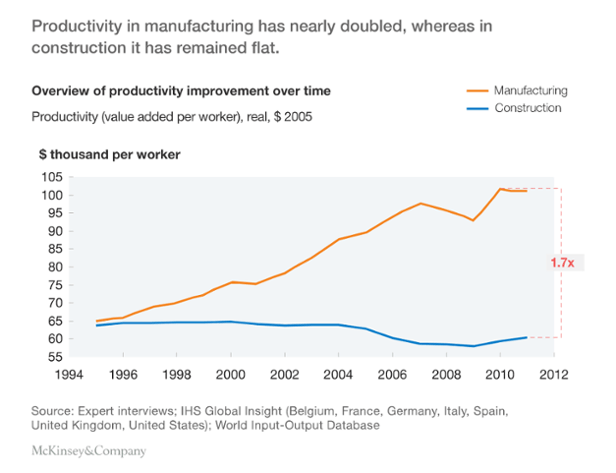 Exhibit 1
Exhibit 1
Source: The construction productivity imperative
Operational challenges faced by construction & engineering firms
Construction and engineering firms face many unique operational challenges, including:
- Complicated and time consuming tender processes, both estimating and securing the right sub-contractors/suppliers for the project.
- Complex and dynamic project management challenges in view of preset deadlines and the large amount of documentation to be shared and managed.
- Collaboration with project stakeholders such as owners, sub-contractors/suppliers, local authorities, architects/engineers and other consultants.
- Keeping on top of administrative tasks such as changes to plans and specifications, budgeting and compliance with OH&S requirements.
- Management and recording of site activities and ensuring that all stakeholders are kept informed.
Use of technology by construction firms
As can be expected, the large Tier 1 firms have the necessary resources to meet these unique challenges, either by having their own in-house system or by using one of the few integrated software systems available in the market. However, the majority of these available systems are designed to meet the needs of the larger firms undertaking mega projects. Many small and medium size firms view such systems as being ‘an overkill’; complex, have more features than they need, difficult to learn and fairly expensive.
Research indicates that many construction firms still use a variety of rudimentary methods to manage these challenges, including:
- Emails/Faxes/post.
- Word documents and Excel spreadsheets.
- Partial use of technology such as stand-alone Notebooks, mobile phones, Tablets and single purpose mobile apps.
- Pieces of paper
- Combination of all the above.
These separate and non-interactive methods fall well short of collecting and communicating project information in a timely and consistent way in order to manage the dynamic tendering and project management challenges successfully.
The 2017 JBKnowledge Construction Technology Report (“the JBK Report”) reveals that the construction industry’s use of technology is still patchy despite the fact that some of the tools being used do not facilitate the timely and consistent capture and sharing of critical project information. The survey carried out by JBKnowledge indicates that the most common factors limiting the use of new technology are lack of IT staff, budgetary constraints, employees resistance to change, management reluctance and lack of IT experience (see Exhibit 2).
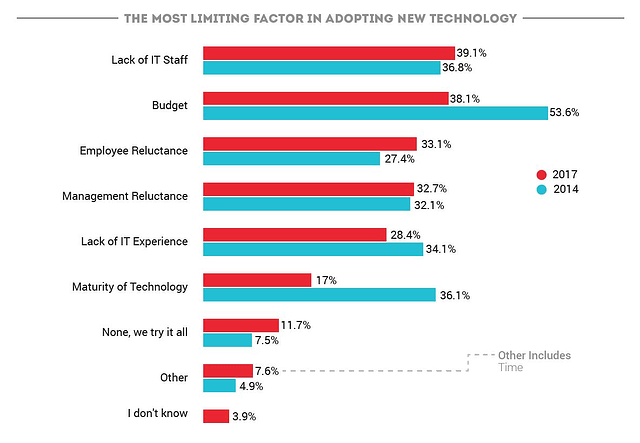
Exhibit 2
Source: 2017 JBKnowledge Construction Technology Report
Use of technology to complete daily tasks
The JBK Report examines the gradual shift towards using technology by the industry in managing daily tasks, as construction firms of all sizes start to realise the huge efficiency gains that can be made.
Exhibit 3 from JBK Report reveals the “workflows most dependent on software” include Accounting with 85% followed by Estimating 60%, Project Management 56% and Project Scheduling at 49%.
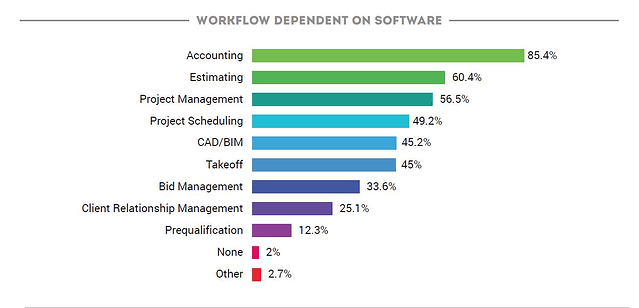
Exhibit 3
Source: 2017 JBKnowledge Construction Technology Report
Oddly, Exhibit 4 from the same report indicates that the same areas shown in Exhibit 3 are reported to be dependent also on spreadsheets, but in a slightly different order (Estimating 70%, Accounting 59%, Project Management 46% and Bid Management 43%).
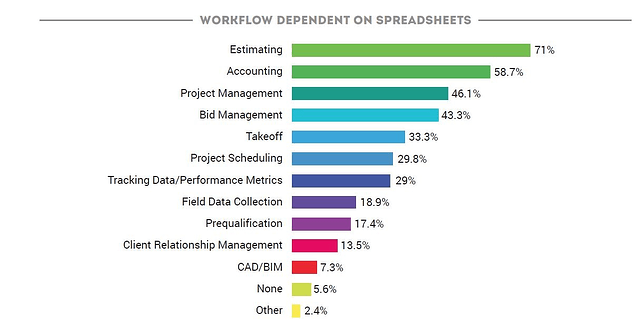 Exhibit 4
Exhibit 4
Source: 2017 JBKnowledge Construction Technology Report
The JBK Report examines the fact that many firms, regardless of size, are still using a combination of software AND conventional spreadsheets. The report suggests that the reasons for this inefficient and costly duplication may be that:
- Spreadsheets are used to transfer data between different software applications that are not integrated, and/or
- The software applications may not provide the required data entry and reporting functionalities that the spreadsheets provide.
Innovative technology companies are working to resolve these issues by placing greater emphasis on user interface (UI) and user experience (UX). Construction software that follows the user’s journey while performing daily tasks will benefit the end users, allowing them to learn and adopt the system quickly, to collaborate more effectively and to eliminate inefficient duplication.
Use of mobile technology
While the construction industry’s general use of technology is still erratic, the advancement in mobile technology has produced benefits that are hard to ignore, and the use of mobile devices by industry as a whole seems to have increased significantly since 2012. Exhibit 5 from the JBK Report shows that 83% of all respondents found mobile capabilities to be “Important” to “Very Important”, compared to 59% in 2012. As the report proclaims, the latest data supports the maxim, “The iPad is the new hammer!”.
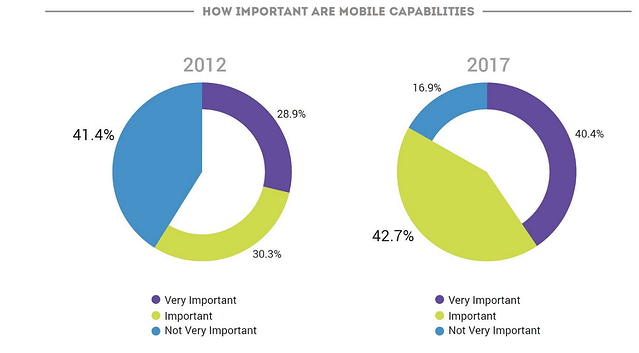 Exhibit 5
Exhibit 5
Source: 2017 JBKnowledge Construction Technology Report
Exhibit 6 offers some insight into the daily use of Mobile Technology within the industry. The number of people using smartphones increased between 2013 and 2017 from 52% to 86%. The use of personal smart phones decreased from 49% in 2013 to 32% in 2017, while the use of company-issued smartphones increased from 52% to 68%. This suggests that construction firms have realized the advantages of using smartphones and started to supply more company-issued devices for use by staff. The number of firms providing tablets also increased from 52% in 2013 to 74% in 2017. Wearables also saw an increase in usage in 2017, with 71% being personal devices.
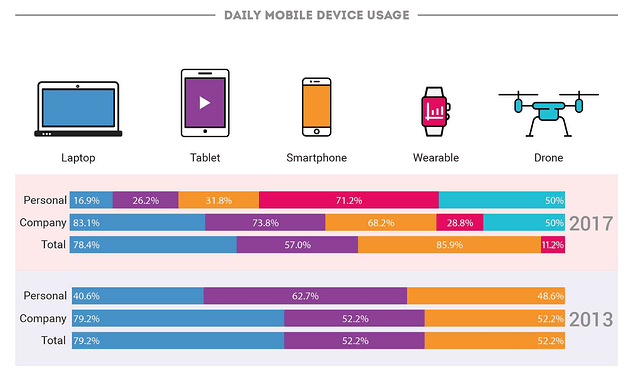 Exhibit 6
Exhibit 6
Source: 2017 JBKnowledge Construction Technology Report
However, in the absence of mobile devices in the field, Exhibit 7 from the earlier 2016 JBKnowledge Construction Technology Report shows that a massive 38% of survey participants said that they use manual processes (e.g. pen and paper) to collect field data, with 25% use spreadsheets and 21% use single-function mobile apps.
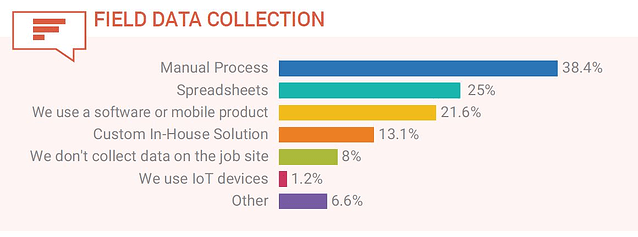
Exhibit 7
Source: 2016 JBKnowledge Construction Technology Report
However, mobile access is only one aspect; the other being the speed of applications. Social media giants such as Facebook have enormous resources to develop their applications to be instantly responsive and are used by more than a billion people each day. These leading applications have set the benchmark of how users expect any application to behave. Focusing on software optimisation for speed will create the experience that construction users expect, and this in turn will lead to greater adoption.
Integration of software applications
The construction process involves teams of numerous businesses working together to complete a project. Head contractors can be simultaneously collaborating with many different companies to complete their projects. Effective collaboration depends on how easily and timely information can flow back and forth.
Some construction technology companies offer a fully integrated end-to-end solution covering every aspect of the construction process in the one system, while others offer products that deal only with a specific part of the process.
Either way, software applications used by the industry need to connect seamlessly with each other in order to provide the right environment for effective collaboration, to eliminate duplication and to minimise risk. Through well-developed application programming interfaces (APIs), connecting a number of specialised systems is possible. This allows the free transfer of data and enables users to continue utilizing their specialised systems without interruption.
An example is connecting a construction management system with and transferring data to and from a CRM system or an accounting system without the need for double entry.
The JBKnowledge Report reveals that only 5.5% of construction professionals surveyed have full integration across all their software applications, 30% have no software integration whatsoever and 36% have integration of only 1 or 2 applications (Exhibit 8).
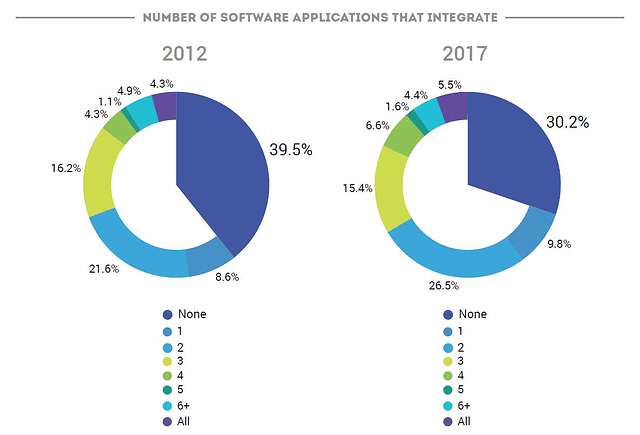 Exhibit 8
Exhibit 8
Source: 2017 JBKnowledge Construction Technology Report
To put this into perspective, Exhibit 9 from the same report reveals that nearly half the construction professionals surveyed said that they transfer data manually if their applications do not integrate, and a further 43% use spreadsheets to transfer data.
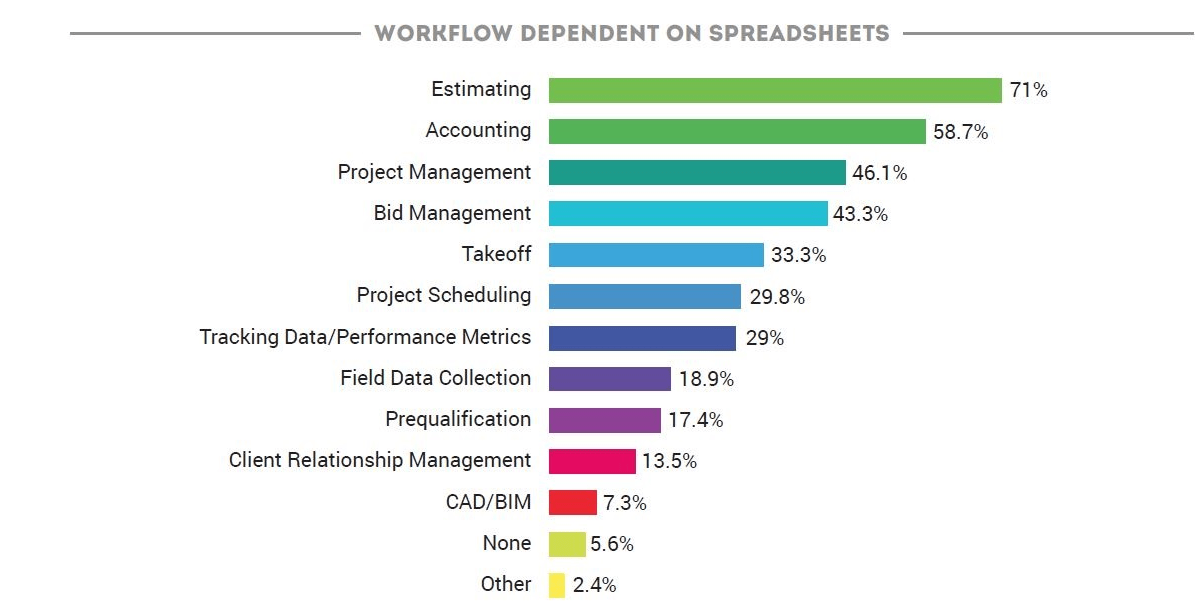 Exhibit 9
Exhibit 9
Source: 2017 JBKnowledge Construction Technology Report
Conclusion
The demand for construction management software will increase, and should see a much greater adoption by the industry in the future. The shift from manual and paper-based processes to digital solutions can happen at a much greater rate with the availability of software systems that are simple to use, provide seamless collaboration between people and technologies, and offer the flexibility to cater for different projects and company requirements.
As mobile technology is becoming an indispensable tool for the construction industry, the use of integrated end-to-end online software systems will optimise the associated benefits of mobile access. This will ultimately save project stakeholders time and money by improving efficiency, enhancing collaboration and ensuring that projects are completed successfully, within budget and on time.






